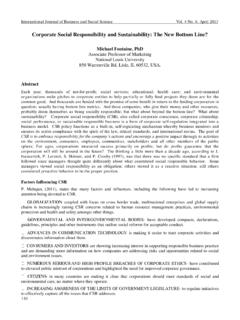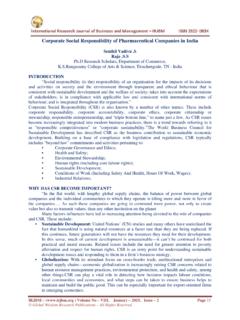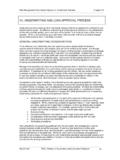Transcription of Basel Committee on Banking Supervision
1 Basel Committee on Banking Supervision Guidelines corporate governance principles for banks July 2015. This publication is available on the BIS website ( ). Bank for International Settlements 2015. All rights reserved. Brief excerpts may be reproduced or translated provided the source is stated. ISBN 978-92-9197-130-5 (print). ISBN 978-92-9197-126-8 (online). Contents Glossary .. 1. corporate governance principles for banks .. 3. Introduction .. 3. Jurisdictional differences .. 5. Applicability, proportionality and differences in governance approaches.
2 6. Principle 1: Board's overall responsibilities .. 8. Principle 2: Board qualifications and composition .. 13. Principle 3: Board's own structure and practices .. 15. Principle 4: Senior management .. 20. Principle 5: Governance of group structures .. 22. Principle 6: Risk management function .. 25. Principle 7: Risk identification, monitoring and controlling .. 27. Principle 8: Risk communication .. 30. Principle 9: 31. Principle 10: Internal audit .. 32. Principle 11: Compensation .. 34. Principle 12: Disclosure and transparency .. 36.
3 Principle 13: The role of supervisors .. 38. corporate governance principles for banks iii Glossary bank or Banking organisation A bank, bank holding company or other company considered by Banking supervisors to be the parent of a Banking group under applicable national law as determined to be appropriate by the entity's national supervisor. board of directors, board The body that supervises management. The structure of the board differs among countries. 1 The use of board throughout this paper encompasses the different national models that exist and should be interpreted in accordance with applicable law within each jurisdiction.
4 Control functions Those functions that have a responsibility independent from management to provide objective assessment, reporting and/or assurance. This includes the risk management function, the compliance function and the internal audit function. corporate governance A set of relationships between a company's management, its board, its shareholders and other stakeholders which provides the structure through which the objectives of the company are set, and the means of attaining those objectives and monitoring It helps define the way authority and responsibility are allocated and how corporate decisions are made.
5 Duty of care The duty of board members to decide and act on an informed and prudent basis with respect to the bank. Often interpreted as requiring board members to approach the affairs of the company the same way that a prudent person would approach his or her own affairs. 2. duty of loyalty The duty of board members to act in good faith in the interest of the company. The duty of loyalty should prevent individual board members from acting in their own interest, or the interest of another individual or group, at the expense of the company and executive director In jurisdictions where this is permitted, a member of the board (eg director) who also has management responsibilities within the bank.
6 3 A non-executive director is a member of the board who does not have management responsibilities within the bank. independent director For the purposes of this paper, a non-executive member of the board who does not have any management responsibilities within the bank and is not under any other undue influence, internal or external, political or ownership, that would impede the board member's exercise of objective internal control system A set of rules and controls governing the bank's organisational and operational structure, including reporting processes, and functions for risk management, compliance and internal audit.
7 Risk appetite: The aggregate level and types of risk a bank is willing to assume, decided in advance and within its risk capacity, to achieve its strategic objectives and business plan. 4. risk appetite framework (RAF) The overall approach, including policies, processes, controls and systems, through 1. See paragraph 15. 2. See the glossary of corporate governance-related terms in Organisation for Economic Co-operation and Development (OECD), Experiences from the Regional corporate Governance Roundtables, 2003. 3. See Financial Stability Board (FSB), Thematic review on risk governance, February 2013.
8 4. See FSB, Principles for an effective risk appetite framework, November 2013. corporate governance principles for banks 1. which risk appetite is established, communicated and monitored. It includes a risk appetite statement, risk limits and an outline of the roles and responsibilities of those overseeing the implementation and monitoring of the RAF. The RAF should consider material risks to the bank, as well as to its reputation vis- -vis policyholders, depositors, investors and customers. The RAF aligns with the bank's strategy. 5. risk appetite statement (RAS) The written articulation of the aggregate level and types of risk that a bank will accept, or avoid, in order to achieve its business objectives.
9 It includes quantitative measures expressed relative to earnings, capital, risk measures, liquidity and other relevant measures as appropriate. It should also include qualitative statements to address reputation and conduct risks as well as money laundering and unethical practices. 6. risk capacity The maximum amount of risk a bank is able to assume given its capital base, risk management and control capabilities as well as its regulatory constraints. risk culture A bank's norms, attitudes and behaviours related to risk awareness, risk-taking and risk management, and controls that shape decisions on risks.
10 Risk culture influences the decisions of management and employees during the day-to-day activities and has an impact on the risks they assume. 7. risk governance framework As part of the overall corporate governance framework, the framework through which the board and management establish and make decisions about the bank's strategy and risk approach; articulate and monitor adherence to risk appetite and risk limits vis- -vis the bank's strategy; and identify, measure, manage and control risks. 8. risk limits Specific quantitative measures or limits based on, for example, forward-looking assumptions that allocate the bank's aggregate risk to business lines, legal entities as relevant, specific risk categories, concentrations and, as appropriate, other risk management The processes established to ensure that all material risks and associated risk concentrations are identified, measured, limited, controlled, mitigated and reported on a timely and comprehensive basis.



















